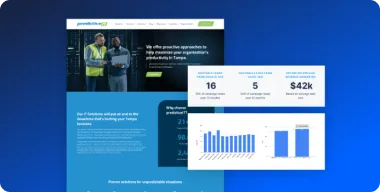For businesses, organizations or individuals wanting to start a new website or blog, the question is usually, “How can I get my name out there and get readers to follow me?”
Quite simply, the most effective way to reach your audience is to create relevant content. Good writing will always have value in any medium, and if your articles also have longevity, they’ll be getting visitors for months and even years to come.
But not all types of content have the same alluring effect. Let’s take a look at some of the tried and tested ones and see whether they’ll work for your blog.
1. Free Guide
Guides can keep bringing in traffic for a long time. Although crafting one might seem daunting, the payoff will be worth it, especially if you work in a technical industry. You’ll want to provide step-by-step and how-to guides that give out just enough information that you’re willing to put out for free and will entice readers to seek out more from you.
The key to creating a free guide is access. Ask for a name and email address prior to the download. These two details are enough, as too many requirements could put your readers off from downloading. Once you have these contact details, get to marketing directly. Email your readers and invite them to become clients or customers.
2. Frequently Asked Questions
This type of content is both convenient and efficient for two main reasons. First, it saves you the trouble of having to answer such frequently asked questions from your readers or customers in forums or comment sections. They’d have a go-to page where they can immediately get answers to their most basic concerns.
Second, it doesn’t really require much research or analysis, as the information you need are most likely already available. If you have support hotlines, you can check with customer service representatives, as they usually have scripts at the ready.
As a bonus: FAQs also improve your visibility among search engines, which have become a primary destination for getting answers to questions.
3. Interview
Interviews also accomplish two things at once: They showcase your company as an expert in your field and highlight a particular luminary in your industry. They’ll also improve your reputation, especially if the interviewee is renowned. You’ll even get to learn something in the process.
It doesn’t matter if the interview is in text or video format, as they are both easily accessible. However, there are certain pros and cons exclusive to each. An e-mail interview is much easier to plan, while a video interview is more engaging. The latter is also relatively more reliable, as people can actually see you are interviewing the expert you named. However, a video interview is more time-consuming to create and to view. Even so, it is very versatile, as it can be transcribed or converted into a ready-made podcast.
4. Video
Creating video content used to be pretty hard and time consuming. Thankfully, venues like Skype and Google+ Hangouts—and their ability to record sessions—have really opened the gates. Nearly everyone has some sort of video recording device now, and the challenge is creating engaging content that people will want to see.
You can use YouTube as a good way to generate links. Embed links inside the video itself or in the About section of the page. Use this tip from distilled.net to direct your embedded links back to your own site instead of back to YouTube.
5. Infographic
A well-crafted infographic is worth the weight of a long explanatory article. This type of content is an effective tool for delivering information quickly and in an easy-to-understand manner.
When making your infographic, make sure to strike a balance between data density and readability. Maximize the advantages of the visual by presenting your content creatively. Finally, the main points should be obvious, presented in bite-size snippets of information, and the conclusions must be clear.
6. Concept visualization
Not to be mistaken for infographics, concept visualizations are more like illustrations to drive your argument in a text article. The other type is more commonly standalone.
Content visualizations, as these visual aids are also known, explain complex or abstract concepts in a way that text simply cannot touch. Think of them as pictures in a children’s book. The best part about both visualizations and infographics is that they can be very easily shared on social networks.
7. Meme
Online culture has its own language and shorthand, and memes are a major part of this new slang. Read up on the most popular memes setting the Internet ablaze (or ask your children) and see how you can make use of them to engage your readers and get them sharing your content.
While this is definitely a fun approach that has the potential to reach a younger audience, you need to stay on top of the trends or you’ll come off as hopelessly outdated.
8. Original data
This is one of the most compelling pieces of content you can create. Conducting your own research and publishing it will establish you as one of the leaders in the industry. If you get cited by your peers and colleagues, you will gain even more respect.
This might seem overwhelming at first, but you probably have all the data you need at your disposal. Sales trends and demographics should be readily available to present in an easy-to-digest form such as the above mentioned visuals.
9. Slideshow presentation
Presentations are another great method to exploit resources that you already have. You probably have tons of these lying around from various meetings or seminars you have conducted.
Tweak them a bit so they don’t reveal too much information about your methods, and post them on your website. This is an effective way to deliver speeches and other content that regular readers might not have access to, so it is bound to be valuable.
10. User-generated content
Once you have a dedicated community, sourcing this should be no problem. It is highly likely that your followers are also part of the industry (or at the very least, are well-informed enthusiasts), so tapping this pool is an easy method for content creation. In exchange for the content they make, the users will gain exposure and even promote their own websites in the process, strengthening your network.
As the Internet continues to grow, establishing a unique business and website will be even more challenging. Using these types of content will help ensure that your site stays meaningful.
Which of these ten methods have worked for you? Are there other effective ways that you can suggest? Let us know in the comments!
About the Author
Kyle Kam is a marketing consultant for Affilorama, an affiliate marketing portal. They also offer, free affiliate marketing lessons for beginning and advance affiliates. You may follow him onTwitter @undisputedkyle.




